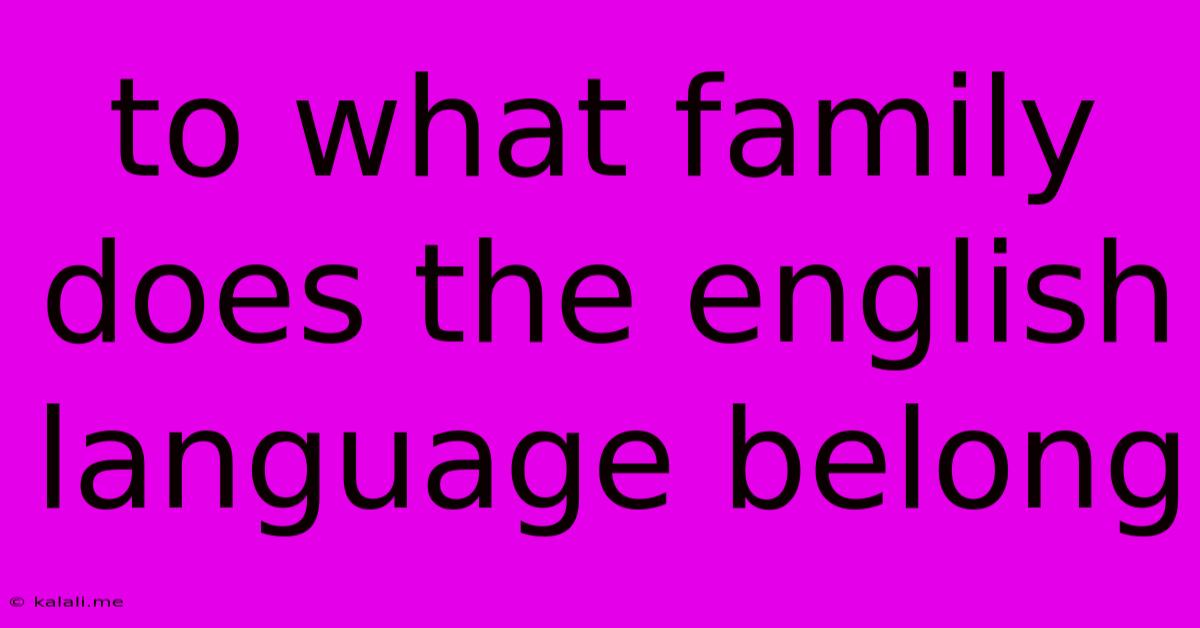To What Family Does The English Language Belong
Kalali
Jun 13, 2025 · 3 min read

Table of Contents
To What Family Does the English Language Belong? A Deep Dive into Indo-European Roots
English, the global lingua franca, boasts a rich and complex history. Understanding its origins is key to appreciating its unique vocabulary and grammatical structures. So, to what family does the English language belong? The answer is the Indo-European language family, a vast and diverse group encompassing hundreds of languages spoken across the globe. This article delves into the fascinating journey of English's linguistic ancestry, exploring its connections to other languages and highlighting key characteristics that place it firmly within this extensive family tree.
This article will explore the Indo-European family, trace English's specific branch within this family, discuss the influences shaping modern English, and touch upon the implications of its linguistic heritage.
The Indo-European Family: A Vast Linguistic Tapestry
The Indo-European language family is a sprawling network of languages, tracing its origins back to a hypothetical ancestor known as Proto-Indo-European (PIE). This reconstructed language, though not directly attested, is inferred through the systematic comparison of its descendants. The sheer geographical spread of its daughter languages is remarkable, encompassing most of Europe and parts of Asia, including languages as diverse as:
- Germanic: English, German, Dutch, Swedish, Icelandic
- Italic: Latin (ancestor of Romance languages like Spanish, French, Italian)
- Slavic: Russian, Polish, Czech
- Indo-Iranian: Hindi, Persian, Sanskrit
- Celtic: Irish, Welsh, Scottish Gaelic
- Greek
- Armenian
- Albanian
- Tocharian (extinct)
The existence of systematic cognates – words with shared ancestry – across these seemingly disparate languages provides strong evidence for their common origin in PIE. For example, the English word "mother" shares cognates in many Indo-European languages, including mater in Latin, mater in Sanskrit, and mutter in German.
Tracing English's Germanic Roots
Within the Indo-European family, English belongs to the Germanic branch, more specifically the West Germanic group. This group also includes languages like German, Dutch, Frisian, and Yiddish. The ancestor of English, Proto-Germanic, diverged from other Germanic languages centuries ago, undergoing its own unique evolution. This evolution significantly shaped English's vocabulary, grammar, and pronunciation.
The Impact of External Influences: Norman Conquest and Beyond
While English's core structure is Germanic, its vocabulary and grammar have been significantly shaped by external influences. The Norman Conquest of 1066 introduced a massive influx of French words into the English lexicon. This resulted in a language with a unique duality: a Germanic grammatical backbone supporting a vocabulary rich with Romance influences. Subsequently, contact with other languages, including Latin, Greek, and various languages from across the British Empire and beyond, continued to enrich the English lexicon.
The Significance of Understanding English's Linguistic Lineage
Understanding English's place within the Indo-European family offers valuable insights into its development and structure. It illuminates the connections between seemingly disparate languages, revealing a shared linguistic heritage. This knowledge enhances appreciation for the complexity and beauty of the English language, providing a deeper understanding of its evolution into the global language it is today. Moreover, this understanding aids in learning other Indo-European languages due to shared vocabulary and grammatical structures.
In conclusion, the English language is unequivocally a member of the Indo-European language family, specifically belonging to the West Germanic branch. Its journey is a testament to the dynamic nature of language, shaped by historical events, cultural exchange, and ongoing linguistic evolution. This understanding provides a rich context for appreciating the richness and complexity of the English language itself.
Latest Posts
Latest Posts
-
Which Term Does Not Belong With The Others
Jun 14, 2025
-
Energy Stored In Bonds Between Atoms Is Called
Jun 14, 2025
-
Which Of The Following Statements Is True Of Intranets
Jun 14, 2025
-
The Perception That A Stationary Object Is Moving Is Called
Jun 14, 2025
-
A Company Will Engage In Test Marketing In Order To
Jun 14, 2025
Related Post
Thank you for visiting our website which covers about To What Family Does The English Language Belong . We hope the information provided has been useful to you. Feel free to contact us if you have any questions or need further assistance. See you next time and don't miss to bookmark.